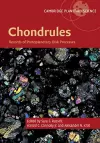
Chondrules
3 contributors - Hardback
£147.00
Sara S. Russell is Head of Planetary Materials at the Natural History Museum, London and Visiting Professor at the Open University. She is a fellow of the Meteoritical Society and has been honoured with the eponymous asteroid 5497 Sararussell. She has been awarded the Antarctica Service Medal of the United States of America and the Bigsby Medal of the Geological Society. Her research interests include the formation of the solar system and the evolution of the moon. Harold C. Connolly, Jr, is founding Chair and Professor in the Department of Geology, School of Earth and Environment, Rowan University, New Jersey. He is also a Research Associate at the American Museum of Natural History and was a special Visiting Professor at Hokkaido University in Sapporo, Japan. He has been awarded the Antarctica Service Medal of the United States of America, and in 2006 Asteroid 6761 Haroldconnolly 1981 EV19 was named in his honour. He is a co-investigator and Mission Sample Scientist for NASA's New Frontiers 3 asteroid sample return mission OSIRIS-REX, and co-investigator for JAXA's asteroid sample return mission, Hayabusa2. He is a fellow of the Meteoritical Society. His career has been devoted to understanding the formation and evolution of primitive planetary materials, chondritic meteorites, to chondrule formation, the formation and dynamical evolution of asteroids, and the origin of Earth-like planets. Alexander N. Krot is a researcher at the University of Hawai'i, Manoa from which he received the Regents' Medal for Excellence in Research in 2004. He has also received a Humboldt Research Award, and an Antarctica Service Medal of the United States of America. He has been recognised by having both an asteroid (6169 Sashakrot Ex4) and a mineral (krotite) named in his honour. He is a fellow of the Meteoritical Society, from which he has been recently awarded the Leonard Medal. His research interests include astrophysical and cosmochemical problems related to the formation and early history of the solar system; chondritic meteorites and refractory inclusions; and isotope chronology.